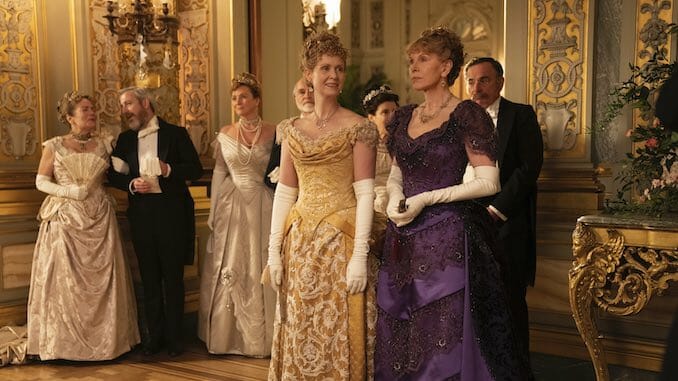The Gilded Age: HBO’s Overstuffed American Downton Abbey Is a Pretty, Muddled Diversion
Photo Courtesy of HBO
The road to The Gilded Age has been a long one. Originally greenlit nearly a decade ago (September 2012) at a completely different network (NBC), the show that arrives on HBO this month bears little resemblance to the property that first bore its title. Initially, The Gilded Age was meant as a Downton Abbey prequel—one that would have focused on a young Cora Levinson from a nouveau riche industrialist family before she was sent to England to marry an Earl with a title but little actual money—but it has obviously undergone several rounds of changes throughout its years-long development process. And while it now has no direct connection to creator Julian Fellowes’ most famous project, without the pre-established Crawley narrative, the series struggles to find a coherent identity of its own.
Ostensibly, the nine episode first season of The Gilded Age is meant to be an exploration of the clash of two very different cultures: The traditional aristocracy of late-nineteenth-century New York—those generally named among Mrs. Astor’s (in)famous four hundred—and the newly (very) wealthy industrialists and entrepreneurs doing their best to essentially buy their way into the city’s social hierarchy and thereby gain respectability.
Agnes van Rhijn (Christine Baranski) is thoroughly traditional, proud of her lineage, and determined that these upstart climbers and annoying newcomers will never crack the protective bubble of what she sees as good society. Now a widow, she married to provide a future and stability for herself and her spinster sister Ada (Cynthia Nixon) after their brother sold everything out from under them when their father died. But when Henry’s daughter, their now-penniless niece Marian Brook (Louisa Jacobson), arrives to stay with them just as ruthless railroad baron George Russell (Morgan Spector) and his wife Bertha (Carrie Coon) move into the ostentatious new house across the street, drama predictably ensues.
This is a very basic description of a series that often has about twelve competing subplots going on at any one time. There’s Marian’s education on the rules of New York society and her growing flirtation with the lawyer who handled her dead father’s estate; Bertha Russell’s singularly furious determination to make the women of New York like her whether they want to or not; George’s often unsavory-seeming business practices; or Agnes’ gay son Oscar (Blake Ritson), on the hunt for a wife who is both very rich and very naive. And that’s all before you get to Turner (Kelley Curran), the scheming lady’s maid who fancies her boss, Bertha’s miserable daughter Gladys (Taissa Farmiga) who chafes under her mother’s demanding rule, or the van Rhijn servant with a gambling problem that Marian (naturally) selflessly helps.
Many of the series’ secondary characters are played by a rotating roster of Broadway luminaries (Nathan Lane! Donna Murphy! Kelli O’Hara! Patrick Page! Audra McDonald!) and the costumes and sets are to die for. Despite the fact there’s too much going on, and a bevy of D-list characters whose names you will never once be motivated to learn, there’s still something here that’s fun to watch, even if you’re never quite sure how the show wants you to view any of these people.
Ostensible heroine Marian is generally presented as a cipher, an audience stand-in who somehow has no real arc of her own. Her best friend Peggy Scott (Denee Benton) is one of the show’s scant handful of characters of color and seems to exist to be the mechanism by which The Gilded Age confronts issues of race. (Something that Fellowes has never been particularly adept at writing, in case anyone’s forgotten that season of Downton where Rose fell in love with a jazz singer.) Here, the show is refreshingly honest about how thoroughly racist almost everyone in New York’s upper crust is, but it’s often as ham-fisted as you might have feared when it comes to actual stories for its Black characters. And it’s hard not to wish for more for Peggy’s family, a rare depiction of Black upper middle class entrepreneurial success in nineteenth-century America.
-

-

-

-

-

-

-

-

-

-

-

-

-

-

-

-

-

-

-

-

-

-

-

-

-

-

-

-

-

-

-

-

-

-

-

-

-

-

-

-








































